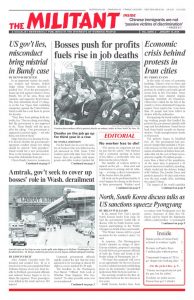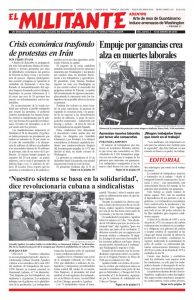In the wake of years of economic hardship, Tehran’s wars in Syria and Iraq, and recent price increases, daily protests by workers and youth spread across Iran in late December. Some participants have chanted slogans opposing Ayatollah Ali Khamenei. Others have called for the fall of the country’s cleric-dominated bourgeois regime. Press reports Jan. 3 say more than 20 people had been killed in clashes with the authorities.
Recognizing the harsh realities facing working people that kindled the protests the government initially held cops and Revolutionary Guard forces back from brutal assaults on demonstrators. Youth unemployment stands at 40 percent.
The protests began in Mashhad Dec. 28. The government had proposed a budget that included a 50 percent increase in fuel costs and elimination of millions of dollars from subsidies that cut the cost of basic necessities for roughly 30 million people — more than a third of the population. At the same time it proposed a 20 percent increase in military spending, which would put the defense budget at $11 billion. The London Times said protests spread to 40 cities and towns over the next couple days, including the capital Tehran.
The impact of the world capitalist crisis, exacerbated by years of sanctions imposed by Washington and its allies, has hit workers and farmers hard. Iranian President Hassan Rouhani negotiated a deal with Washington to slow down the development of Tehran’s nuclear program in exchange for lifting some sanctions. This raised hopes among working people of an easing of the economic crunch.
Rouhani was re-elected president last May on these hopes, on a pledge to expand Tehran’s economy and promises there would be no return to rampant inflation. In spite of some new trade — including with Boeing and Airbus — workers’ living standards have continued to decline.
These conditions have fueled discontent with both wings of the country’s ruling clerics, those led by Ayatollah Khamenei and by Rouhani. The clerics consolidated capitalist rule in a counterrevolution following the 1979 uprising by working people that overthrew the shah, a close ally of Washington.
Protests spread Dec. 29 to Kermanshah, a largely Kurdish city in western Iran. In November demonstrations there were organized to oppose the government’s paltry assistance to the victims of an earthquake that killed 436 people and destroyed 12,000 houses.
Rouhani said Dec. 31 that Iranians were “completely free” to protest. Protesters still faced cops’ tear gas, water cannons and arrests.
In Tehran and other cities, some demonstrators have reportedly raised demands for the removal of Supreme Leader Khamenei.
Tehran’s wars deepen economic crisis
In the course of wars in Syria and Iraq, Revolutionary Guard forces and Tehran-backed militias played a key role in pushing back the Syrian people’s attempts to overturn the Bashar al-Assad dictatorship, a Tehran ally, and helped expand Tehran’s sway across the region.
But Tehran’s rising regional clout — aimed at advancing the interests of the country’s counterrevolutionary leaders and its capitalist class — comes as conditions for millions of working people at home have deteriorated. Denunciation of the Iranian rulers’ foreign interventions marked a number of the protests. Some demonstrators chanted, “Forget about Syria, think about us” and “Forget Palestine.”
Tehran falsely claims it backs Palestinian national rights and attempts to blame all ills in Iran on conspiracies from the government in Israel. In fact, Tehran helps fund Hamas, the anti-working-class Islamist group that rules the Gaza Strip.
Tehran also extended $4.6 billion in credit to the Assad regime between 2013 and 2015. The death toll among Iranian-backed forces operating in Syria and Iraq rose sharply after 2015 and includes at least 500 Iranians.
On Jan. 2 Khamenei accused Washington, Tel Aviv and their allies of fomenting the protests. The next day pro-Khamenei marches took place in Tehran and some other cities with participants chanting, “We will not leave our leader alone,” Reuters reported.
Major Gen. Mohammad Ali Jafari, commander of the Revolutionary Guards, announced he was deploying the force into Isfahan, Lorestan and Hamadan provinces — where some of the largest protests have occurred — to confront “the new sedition.”
At the same time, Rouhani’s government took steps to try and defuse protesters’ demands for economic concessions by backing down on moves to raise fuel prices.

